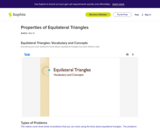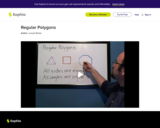
Use examples to solve for the angles of equilateral triangles in a PowerPoint presentation. Includes video. [4:18]
- Subject:
- Mathematics
- Material Type:
- Audio/Video
- Provider:
- Sophia Learning
- Date Added:
- 12/01/2023

Use examples to solve for the angles of equilateral triangles in a PowerPoint presentation. Includes video. [4:18]

Equilateral triangles are explored in this learning tutorial, which includes several videos [4:18; 4:18; 3:18] and a PowerPoint presentation. The lesson includes an introduction of equilateral triangles and their key characteristics. Demonstrations are provided that solve problems involving area and angle measurements.

This lesson will provide an understanding of the chemical and physical nature of water. It is 1 of 4 in the series titled "The Properties of Water."

Created to teach students of the 21st century, SOPHIA is bringing the world of psychology straight to your fingertips. Become the commander of your own learning experiences as you take part in this interactive lesson regarding the fundamental attribution error. [10:25]

Find the area of several figures to prove the Pythagorean theorem. Complete quiz to check understanding. [5:16]

This video lesson [4:55] describes the characteristics that quadrilaterals and triangles have in common. Students can check their understanding with an assessment.

Explore the difference between qualitative and quantitative observations when doing scientific investigations. [1:12]

Practice using probability to describe the location of electrons in the atomic model. [3:25]

This lesson [4:18] goes over how to recognize and correct sentences that are overly long. This tutorial lesson shares a short screencast with the lesson's content.

This lesson explains how to read with purpose in mind. This tutorial shares a short audio lesson [1:48] and supplemental notes with the lesson's content.

Use real-world applications to explore inverse trigonometric functions and then assess learning with a quiz. [5:57]

This tutorial focuses on prepositional phrases and their modifiers. It offers a video lesson including a list of common prepositions and how to punctuate prepositional phrases at the beginning and end of sentences. Real Player is required.

This video tutorial reviews how to recognize the difference of two squares, which is useful for understanding polynomial identities. Includes short multiple-choice quiz. [1:33]

A narrated lesson examining the structure, function, and production of new red blood cells. [5:20]

This lesson explains how to reference an author's purpose when answering a reading comprehension question. This tutorial shares an audio version of the lesson's content. [3:14] RI.11-12.6 Eval Purpose, Rhetoric, Style

In this video tutorial, students will determine if a polygon is regular by examining the sides and angles for congruency. Check understanding by the assessment. [2:06]

Relationships among the six trigonometric functions are explored in this lesson. It is 3 of 4 in the series titled "Relationships of Trigonometric Functions." Includes short quiz. [4:46]

This lesson will introduce experimental and subjective definitions of probability. It is 1 of 3 in the series titled "Relative Frequency Probability/Empirical Method." Includes short quiz. [5:31]

This lesson will introduce experimental and subjective definitions of probability. It is 2 of 3 in the series titled "Relative Frequency Probability/Empirical Method." Includes short quiz. [7:12]

This lesson will introduce experimental and subjective definitions of probability. It is 3 of 3 in the series titled "Relative Frequency Probability/Empirical Method." Includes transcript of video and a short quiz. [5:26]